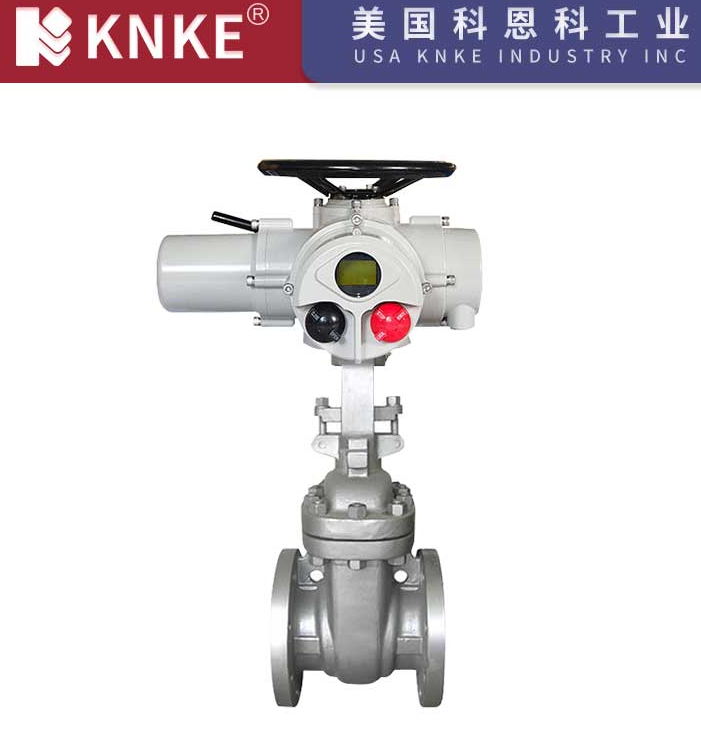Electric Gate Valve | Working Principle, Types, Applications & Selection Guide
In the field of industrial automation and fluid control, the electric gate valve has become an essential actuator thanks to its efficiency, precision, and energy-saving characteristics. This article explains the working principle, main types, applications, and key points for selecting and maintaining electric gate valves—helping engineers and purchasers make the right decisions.
1. What Is an Electric Gate Valve?

An electric gate valve is an automatic control valve composed of an electric actuator and a gate valve body. The electric actuator drives the valve stem to raise or lower the gate, thereby opening or closing the fluid passage.
Compared with manual gate valves, electric gate valves offer several advantages:
- Remote and automated control – can be operated via electrical signals, suitable for unmanned systems.
- Smooth opening and closing – controlled motor speed reduces impact and noise.
- Excellent sealing performance – wedge or elastic gate structures ensure zero leakage.
- Wide medium compatibility – applicable to water, steam, oil, acid, alkali, and natural gas.
2. Main Types of Electric Gate Valves
Depending on their structure and application, electric gate valves can be divided into several types:
- Wedge Type Electric Gate Valve
- Wedge-shaped gate, providing tight sealing.
- Suitable for high-temperature and high-pressure conditions such as power plants.
- Parallel Type Electric Gate Valve
- Flat gate design with minimal flow resistance.
- Common in petroleum and chemical industries for large-flow pipelines.
- Flexible (Elastic) Gate Type
- Elastic gate allows self-compensation of sealing gaps.
- Ideal for pipelines prone to scaling or temperature variation.
- Rising Stem vs. Non-rising Stem
- Rising stem: visible stem movement for easy position observation.
- Non-rising stem: compact design, suitable for limited spaces.
3. Applications of Electric Gate Valves
Electric gate valves are widely used in:
- Municipal water supply and drainage systems
- Power generation and metallurgy – for steam and cooling water pipelines
- Petrochemical industry – for oil, gas, and corrosive medium transport
- Pharmaceutical and food processing – hygienic stainless-steel gate valves
- Environmental engineering – wastewater and exhaust gas treatment systems
4. Key Factors in Selecting an Electric Gate Valve
When choosing an electric gate valve, consider the following aspects:
- Nominal diameter (DN) and pressure rating (PN)
Match with pipeline flow and pressure requirements. - Body material
- Stainless steel: excellent corrosion resistance, ideal for chemical processes.
- Cast steel or ductile iron: cost-effective for general applications.
- Actuator type
- On–off actuator: for simple open/close control.
- Modulating actuator: allows proportional flow control.
- Protection and explosion-proof rating
Choose IP67 or Ex-proof actuators for outdoor or hazardous environments. - Control mode
Supports local, remote, 4–20 mA analog, or intelligent bus protocols (e.g., Modbus, Profibus).
5. Installation and Maintenance Tips
- Pre-installation inspection – verify valve specifications and sealing surfaces.
- Installation position – keep the actuator upright; avoid vibration and humidity.
- Electrical wiring – follow wiring diagrams carefully to ensure correct power supply.
- Regular maintenance – perform open/close tests and lubrication every 3–6 months.
- Seal protection – keep valve half-open when idle for long periods to prevent scaling.
With high automation, reliable sealing, and broad adaptability, the electric gate valve plays a vital role in modern industrial pipeline systems. Proper selection based on medium type, temperature, pressure, and control method ensures safe, stable, and energy-efficient operation.
